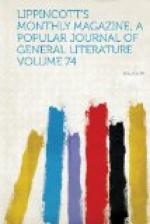His sword hung tasseled at his side,
His purple scarf was floating wide,
And all his raiment many-dyed,
As if he came to seek a bride,
And not the combat that he
sought;
Yet rode he like a prince, and one
Native to noble deeds alone,
Who many a valiant tilt had run,
And many a prize of tourney won
In Arthur’s lists at
Camelot.
Cool grasses and green mosses made
Soft carpet for his charger’s tread,
As ’neath the oak boughs dark o’erhead,
By belts of pasture scant of shade,
Into the Castle Town he rode:
He heard, as things are heard in dreams,
The sound of far-off falling streams,
The shriller bird-choir’s evening
hymns:
He saw but only helmet-gleams,
The smith that smote, the
fire that glowed,
The sheen of lances, and the cloud
From many a field-forge fire, the crowd
Of gay-clad squires, and, neighing loud,
The war-horse with rich trappings proud,
That arched his neck and pawed
the ground;
Old armorers grave and stern in stall,
Where low-crowned morions, helmets tall,
Shone gilt and burnished on the wall;
And, shining brighter than them all,
The eyes of maidens sun-embrowned.
Martin I. Griffin.
SKETCHES OF EASTERN TRAVEL.
I.—THE COUNT DE BEAUVOIR IN CHINA.
Within the last twenty years the East has opened wide its gates, and China, Japan and India are as anxious to become acquainted with the later but more fully developed civilizations of Europe and this country as we are to examine their social, political and industrial systems. We have had accounts from English, American, German and French travelers in the East, each tinged, in a measure, with the national spirit of their respective countries. In the case of the traveler, as of the astronomer, a certain allowance, known as the personal equation, has to be made in receiving the accounts of his observations.
[Illustration: The mandarin CHING’S cart.]
The journey round the world made by the count de Beauvoir in company with the duke de Penthievre, son of the prince de Joinville, is entitled to especial notice, as the attentions shown to the travelers by the Chinese and Japanese authorities enabled them to obtain the best conditions for investigating various matters of interest.
On landing at Shanghai their hearts were gladdened by seeing “on the quay a French custom-house official, with his kepi over his ear, his rattan in his hand, dressed in a dark-green tunic, and full of the inquisitiveness of the customs inspector—as martial and as authoritative as in his native land.” The appearance of the population here struck our travelers as different from that of the native Chinese farther south. Those were yellow, copper-colored, lean,




